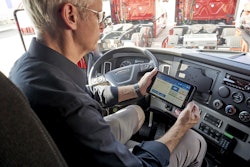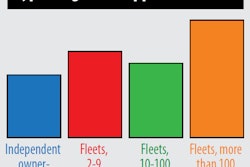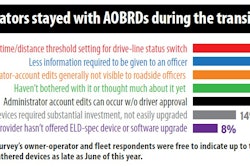Previously in this series: The mandate’s last roundup: The AOBRD-to-ELD shift
For owner-operator Henry Albert, who switched from the Continental VDO RoadLog’s AOBRD version to its ELD around the time of the mandate’s first enforcement deadline, edit limitations amount to the only significant difference between the two specifications. When it comes to drive time, with an AOBRD, you can edit at will from your administrator account, he says. With an ELD, “you can’t ever edit drive time, even if you make a mistake and move it across the parking lot,” triggering the 5-mph switch to driving mode and interrupting your 10-hour break.
 One-truck independent Henry Albert sees negligible difference between the AOBRD and ELD specifications except for difficulty editing away mistakes when it comes to drive time. The
One-truck independent Henry Albert sees negligible difference between the AOBRD and ELD specifications except for difficulty editing away mistakes when it comes to drive time. Thefew times he’s interrupted an off-duty period by moving the truck and not selecting a special driving category to classify the time, “I was able to recap my way through it,” using the rolling cumulative available hours system.
What he means is that all vehicle movement above 5 mph with an ELD has to be accounted for, whether as legitimate driving time, a yard or personal conveyance move (discussed in the previous section of this series), or assigned to another user. A related difference is the visibility of all that time, and any edits, at roadside.
With AOBRDs, edits made in the back office as a general rule don’t present to the roadside officer. Reports abound on social media and elsewhere of back-office e-log edits at fleets using them under the AOBRD standard. Overdrive/CCJ reports in the weeks prior to the mandate’s start showed one ELD provider advertising this feature as an attractive means of hiding drive time. That was never completely true, however, given that log edit history within AOBRDs is required to be preserved, easily discoverable by a state or federal auditor who knows what they’re doing.
Under the ELD specification, however, data transmittal at roadside by one of the four new data-transfer methods specified in the rule includes those edits. It also includes detailed records of the truck’s GPS positions, engine on-off records, engine hours and the like.
Concern over the wealth of data capable of being cherry-picked by an officer having a bad day was the second most prominent reason survey respondents chose for sticking with AOBRDs through the two-year grandfather period. That was followed closely by back-office edits being visible at roadside.
A further burden for fleets large enough to have maintenance staff is the need to build profiles for maintenance personnel who make in-house yard moves. Otherwise, “unassigned miles” can pile up, causing issues at roadside or during an audit, says Mark White, operations manager for Old Time Express, based in Hartsville, Tennessee.
Having long used an Omnitracs AOBRD e-log system before the fleet began its transition to the ELD specification, unassigned driving time accumulated around the yard wasn’t much of a consideration. But now when a driver brings his truck to the yard on a Friday, parks it, goes off duty and heads home for the weekend, shop personnel moving that truck to Old Time’s service bays will show at roadside next week as unassigned driving time associated with that truck’s driver if shop personnel don’t log in first and classify the move appropriately.
“We can live with this little inconvenience,” White says. If shop personnel forget to log in, reassigning that drive time around the yard to them has to be approved by the driver as a change to his log. That’s yet another step that didn’t exist before the ELD rule — and another reason for more training.
Echoing Nussbaum’s Jeremy Stickling, Houston-based former driver Doug Fry, now safety director for a 200-truck fleet, says ELD operation requires “retraining our entire workforce, both drivers and office staff, on the new requirements. Frankly, that can be a bit overwhelming.”
Training on how to operate e-logs when it comes to roadside inspection procedures also is likely for company drivers and owner-operators leased to carriers still using AOBRDs. With ELDs, in addition to the ability (depending on officer discretion) to hand over your device to see the display, full data transfer can occur in four new ways. These depend largely on the device and what the jurisdiction’s capable of receiving: email, website, local Bluetooth or USB stick. –Aaron Huff contributed to this report.
Next in this series: Hours edits: Drivers in full control with ELDs











